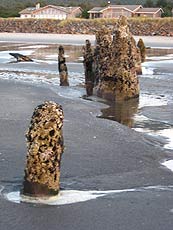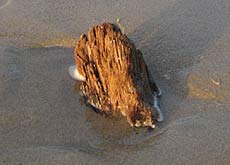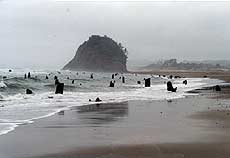 |
More Oregon Coast Discoveries: Possible Doom for Ghost Forest
Published 2008
 |
| The stumps at Neskowin may be endangered by the very sand erosion that exposed them |
(Pacific City) – The now-infamous sand erosion on Oregon’s coast that has resulted in a flurry of finds is creating another scientific drama, this time near Pacific City, between Lincoln City and Tillamook.
It’s been a season of spectacular shipwrecks, ghost forests ranging in age of 1000 years to 4000 years old, historical finds of potentially big significance and odd geological structures normally buried well beneath the sand in various areas along the coast. So far, nothing big has popped up in the Pacific City area, but now it has.
Sand levels at Cape Kiwanda State Park are something like ten feet lower than normal, resulting in major finds for agate hunters, but also more ghost forest stumps, and the beach has quite literally hit rock bottom with a 16 million-year-old formation making its debut.
 |
| The bedrock exposed at Cape Kiwanda is probably 16 million years old |
However, this sand level event has resulted in the possible endangerment of a ghost forest in Neskowin, just a few miles south of Pacific City.
Beach ranger David Woody, with Oregon State Parks and Recreation Department, said the stumps at Neskowin – about 1,000 to 2,000 years old – are showing so much they’re starting to get uprooted.
“I found some a ways up the road, at the beach at Winema,” Woody said.
At the Oregon Department of Gem and Mineral Industries, geomorphologist Jonathan Allan and geologist Roger Hart said they were aware of several of these stumps being removed by erosion.
 |
| Neskowin's ghost forest covered in barnacles: you're starting to see some of these so exposed they don't have barnacles |
“In my opinion, this past winter’s erosion of the buried forests has been more severe than ever before,” Hart said.” Waves have torn up Sitka spruce trees that were rooted in place for one to two thousand years at Neskowin, south of Proposal Rock, and at Cape Lookout State Park, along with great chunks of forest soil. They’ve strewn them all over beaches between Cascade Head and Cape Meares.”
Normally, the ghost forest tree limbs and stumps at Neskowin collect barnacles and other sea life clinging to it during times when the tide surrounds it, especially after periods when sand levels have rushed back up. It’s the same dynamic as many rocks at tide pools, where they suddenly show patches without sea life because sand levels have shrunk to expose an area that was normally off limits to these creatures.
But even these specimens at Neskowin – which are ironically the result of sand levels sinking low enough to expose them in the first place - are getting exposed so much they’re showing bare bark.
 “I’ve seen a lot of stumps without barnacles on them, where the sand has gone away,” Woody said.
“I’ve seen a lot of stumps without barnacles on them, where the sand has gone away,” Woody said.
The ghost forest at Neskowin is probably the most spectacular example of ancient, preserved stumps on the Oregon coast. They are the most dramatic looking, the largest on Oregon beaches, and they are visible year round. Most such stumps on the central coast – when they make they’re appearance - are not even stumps any longer. They’re simply root systems which look like giant octopuses frozen in the sand. This is because early European pioneers to the area sawed them off for their wood needs when they discovered them.
But the ones at Neskowin make for interesting shapes – all approximately 100 of them. The cruel irony is that they’re still kind of a secret attraction to the coast, not one well known by any means. These recent developments could spell their doom in the coming years, before they get a chance to become a major draw for visitors.
“I've been working with the Neskowin Valley School on a study of the Neskowin ghost forest,” Hart said. “The study is tied to a National Science Foundation grant on the possible effects of climate change. Is the forest being destroyed now because of an increase in erosion? The ghost forest at Neskowin is especially worth visiting.”
 |
| Stump at Cape Kiwanda State Park |
Cape Kiwanda State Park is one of those hidden spots on the coast, not even marked with a sign. The entrance – down a one-lane road – is about one mile north of the edge of Pacific City. Once here, driving is allowed, and you can travel to the mysterious northern face of Cape Kiwanda.
Here is where sand levels have dropped ten feet or more than usual – another example of the extreme erosion which allowed the discovery of those two cannons near Cannon Beach that shook the national news media. But here, small hints of a ghost forest have popped up, as has a unique rock formation that is about 16 million years old.
 |
| The beach at the state park is a graveyard of formerly buried objects |
“The platform cut into sandstone at Cape Kiwanda was exposed like this in 1998,” Hart said. “There were also some tree stumps on the landward edge of the beach.
“I feel relatively confident, judging from the color of the stump in your photo, that it is Holocene in age, probably between one and two thousand years old.”
A massive formation of bedrock has shown itself, next to the small basalt headland that juts out from the cliff in this secret beach. Much of the beach is a vast bed of polished, round stones and gravel beds that have been exposed by this erosion – a key sign that it’s good hunting for agate and other collectable rocks.
 |
| Another ancient stump at Kiwanda |
The basalt headland and its bedrock companion are part of gargantuan lava flows that oozed their way across what would later become Oregon, from a spot in eastern Oregon. These kinds of eruptions happened dozens, maybe hundreds of times over tens of millions of years, wiping out entire forests and petrifying some of them in rock (you can see this at Silver Creek Falls State Park). It’s a disturbing and frightening scene to imagine: walls of lava searing their way across the state, sometimes twenty feet high.
They often hardened into dike formations, which caused more lava flows to pool up inside them. Hart said this bedrock is just that kind of formation.
 |
| A huge formation of basalt bedrock is exposed |
“The basalt dike is probably 16 million years old, part of the Columbia River Basalt lava
flows,” he said.
Experts like Allan and Hart say this erosion is a natural event, although there is something a little unusual about it this time around.
“Because of the generally higher than normal wave energies experienced over this winter, particularly the December 2 and 3 and January 9 storms, beaches along much of the coast have undergone significant erosion,” Allan said. “Vertical lowering of the beach sand elevation normally averages about three to nine feet of lowering in the winter relative to summer sand elevations, as well as the landward retreat of the beach face and dune. As a result, we are now seeing buried forests being exhumed in areas where they were previously buried and not apparent, exposure of the bedrock on which the sand beach is perched, and exhumation of cannons, boats and the like.
 |
| Ghost forest at Neskowin, with Proposal Rock in the foreground |
“This is a perfectly natural process, with the caveat that the erosion we are seeing now comes on the heel of almost 10 years now of above-average wave energy levels, which has contributed to significant erosion along the coast.
“In other words the erosion is cumulative over the past 10 years, with little recovery of the beaches taking place in the summer months.”
Woody also noticed that in recent years the replenishing of sand levels hasn’t been as much as before.
For those wanting to hunt for more ghost forests and more interesting beach treasures, now is the perfect time, say geologists and beach experts. Sand levels will likely return to normal soon. One night can mean a difference of three feet of sand coming back.
 |
| Part of the basalt headland at Cape Kiwanda State Park |
However, two weather systems on either side of this coming weekend are going to mean large surf, and possibly more erosion. Then Sunday is supposed to be absolutely beautiful on the coast: perfect for more beachcombing.
You can find more ghost forests at Hug Point (near Cannon Beach), immediately south of there at Arch Cape, at Cape Lookout State Park, as well as Thiel Creek and Lost Creek just north of Seal Rock.
Woody said a small amount of stump root systems are showing at Moolack Beach, just north of Newport.
 |
| Neskowin stump up close |
Hart recommends looking at the southern end of what are called “littoral cells” – meaning the stretches of beaches between headlands. For example, the tens of miles between Cape Lookout and Cascade is one cell; between Tillamook Head and Arch Cape is another littoral cell, etc.
“Great stretches of buried forest are also exposed near Yachats and along beaches in south Lincoln County, especially near the south end of littoral cells,” Hart said.
Essentially, look for the northern face of a large headland like Cascade Head, Cape Kiwanda or Cape Perpetua.
Whatever is happening, whether or not it’s threatening longstanding or more recent attractions to the coast, it has geologists and other beach experts mesmerized and excited, beyond the historians who are dancing in glee over shipwrecks and other artifacts being found.
Tom Horning, a geologist in Seaside, is also excited about all the recent geologic developments on the beach.
“Very interesting erosion this winter,” Horning said. “I think I need to take a long day and work my favorite places.”
More About Oregon Coast hotels, lodging.....
More About Oregon Coast Restaurants, Dining.....
LATEST OREGON COAST NEWS STORIES
Oregon Coast Whales - Guide to Whale Watching; Whale News, Blog |
Back to Oregon Coast
Contact Advertise on BeachConnection.net
Secrets of the Season |
Unusual Travel Articles TravelParanormal.com allows you to submit your own creepy tale or debunk one - or see up-to-the-minute news headlines about travel and the paranormal. News Headlines from All Over Oregon Need to scan Oregon headlines? Constantly updated news from all over Oregon: a comprehensive, up-to-the-minute display of news headlines from a variety of media |








































